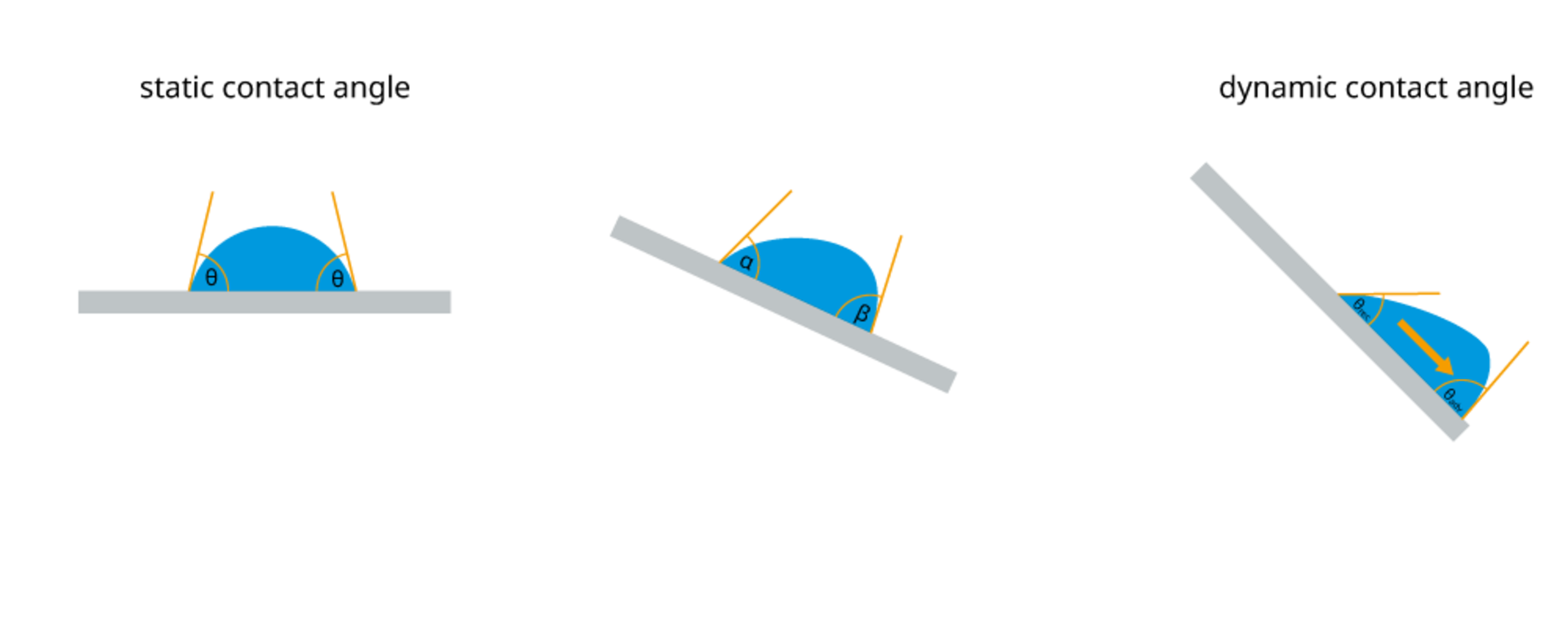Receding angle
The receding angle (receding contact angle, RCA) is the contact angle between a liquid and a solid that has already been wetted with the liquid, which occurs in the course of dewetting. The opposite of the receding angle is the advancing angle that occurs during wetting.
Why is a distinction made between the receding angle and the advancing angle? Isn't the contact angle always the same?
The receding angle is usually smaller than the advancing angle. For example, the liquid often fills depressions in rough surfaces during wetting, which has an effect on the behavior during dewetting. Chemical inhomogeneity also plays a role. In addition, an adsorption layer often forms on the substrate, so that the chemistry of the surface changes as a result of wetting. The difference between the advancing angle and the receding angle is referred to as hysteresis.
Thermodynamically, the different states that the measured contact angle assumes with non-ideal surfaces are described by the occurrence of energy barriers, which lead to metastable states of the contact angle. [1]
Why is the receding angle measured?
Even if the advancing angle has been measured far more frequently up to now, it makes sense in many cases to look at the dewetting behavior and also the hysteresis. How good a hydrophobic coating is, for example, can only be comprehensively assessed if the dewetting behavior is also considered.
In many technical processes, wetting and dewetting processes take place simultaneously, so that both processes should also be considered in the surface analysis.
You can find out more about the applications of the receding angle in the articles on dewetting and hysteresis.
What measurement methods exist for the receding angle?
There are a number of measurement methods for the receding angle, which are based on video image analysis, or mechanical measurement of the capillary force with a tensiometer.
- Stood-up Drop: Jetting a drop of water onto the surface with high dynamics. The drop initially spreads out flat and then contracts very quickly to form a defined drop. The measured value resulting from the drop shape analysis is the recently receded contact angle (RRCA), which, strictly speaking, is not a genuine receding angle.
- Volume reduction: Aspiration of liquid from a dosed drop using a needle dosing unit. With this method, the advancing and receding angles are usually measured one after the other.

- Contact angle measurement according to Wilhelmy: The force sensor of a tensiometer measures the wetting force (capillary force) on a mostly plate-shaped solid or a fiber. The sample is first immersed in the liquid (measurement of the advancing angle) and then pulled out again (measurement of the receding angle).
- Measurement on a sliding drop: The drop moves due to the induced inclination of a surface. At the front of the direction of movement, the droplet wets the substrate, while dewetting takes place on the other side. The advancing angle and receding angle are determined simultaneously from the drop contour analysis.

- Meniscus method: Optical measurement of the fiber contact angle based on the meniscus that forms on an immersed fiber. Similar to the Wilhelmy method, the advancing and receding angles are measured when the fiber is immersed and pulled out.
Literature
[1] Z. B. W. Drelich, Contact angles: From past mistakes to new developments through liquid-solid adhesion measurements. In: Advances in Colloid and Interface Science 267 (2019) 1-14.



